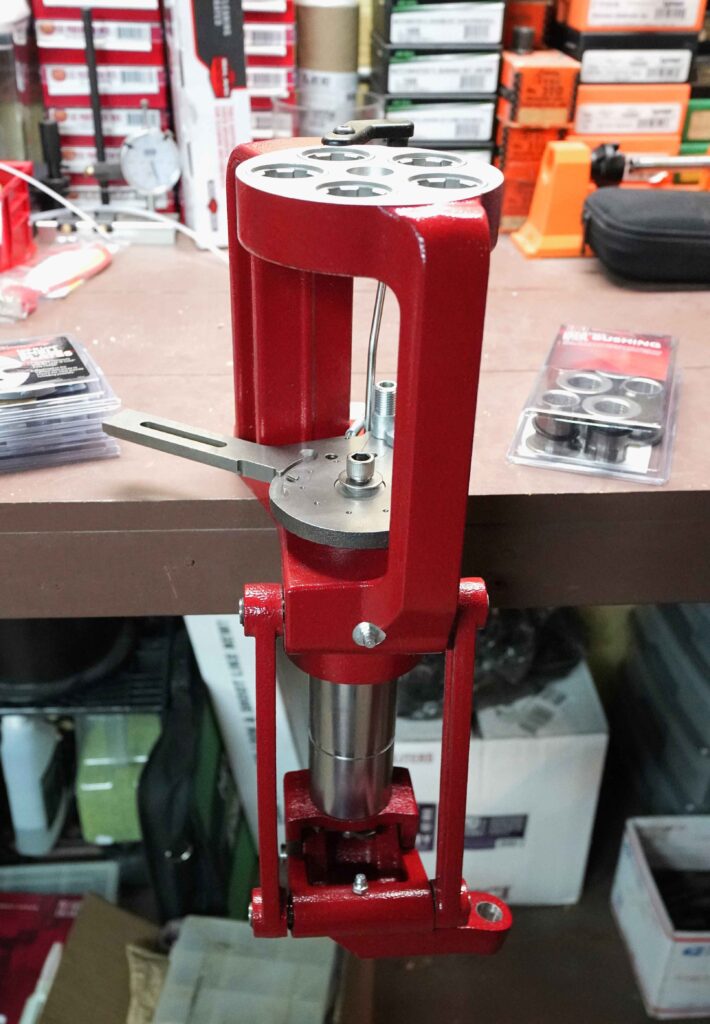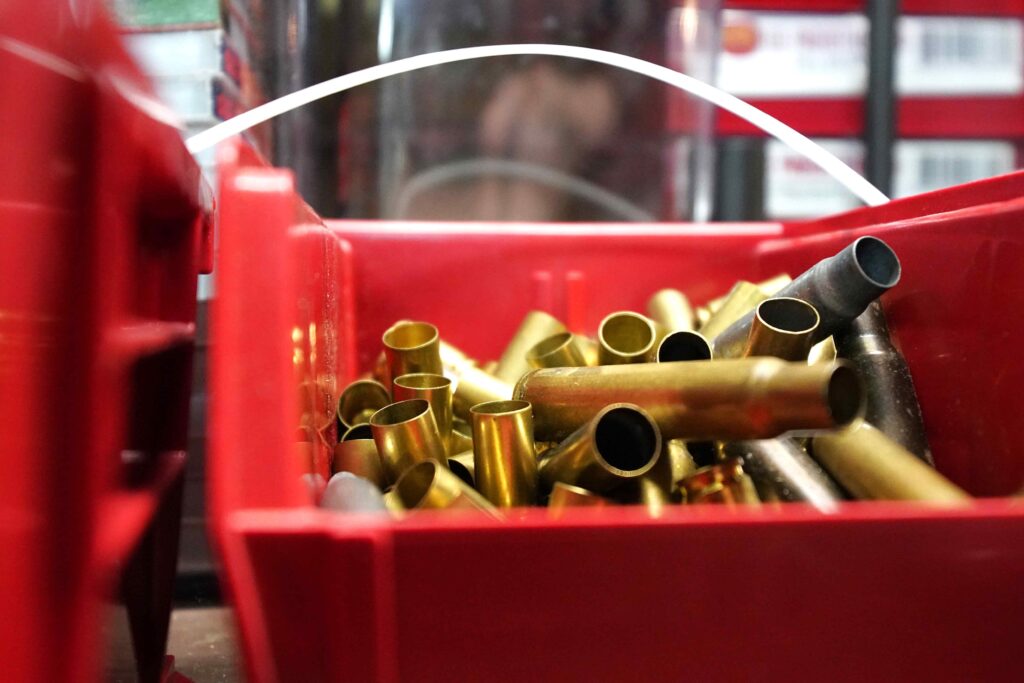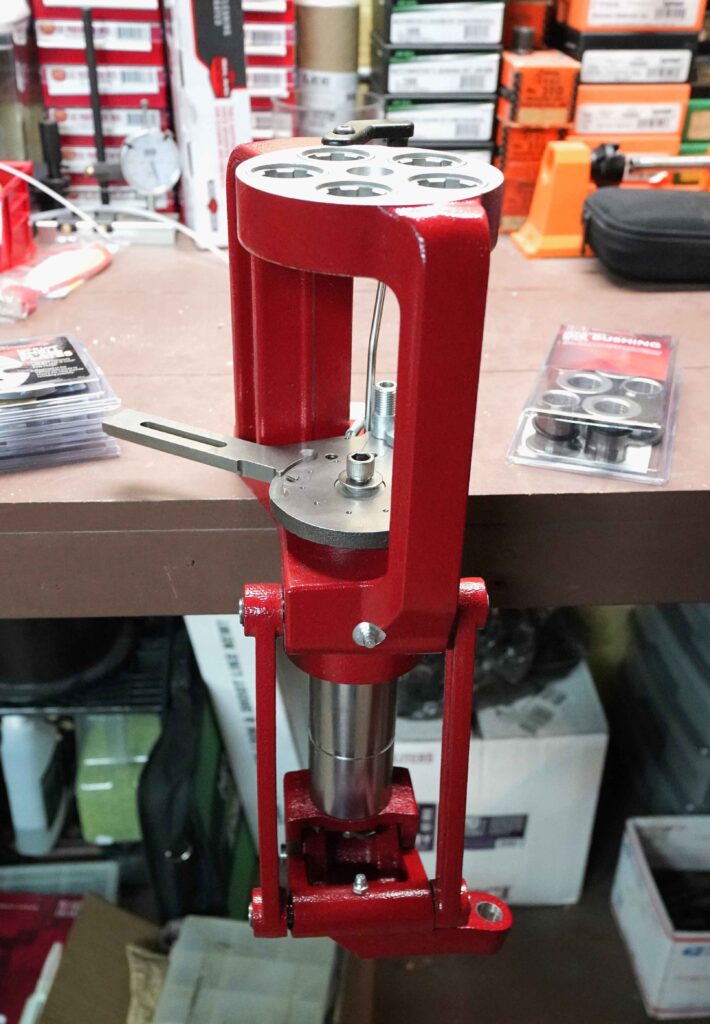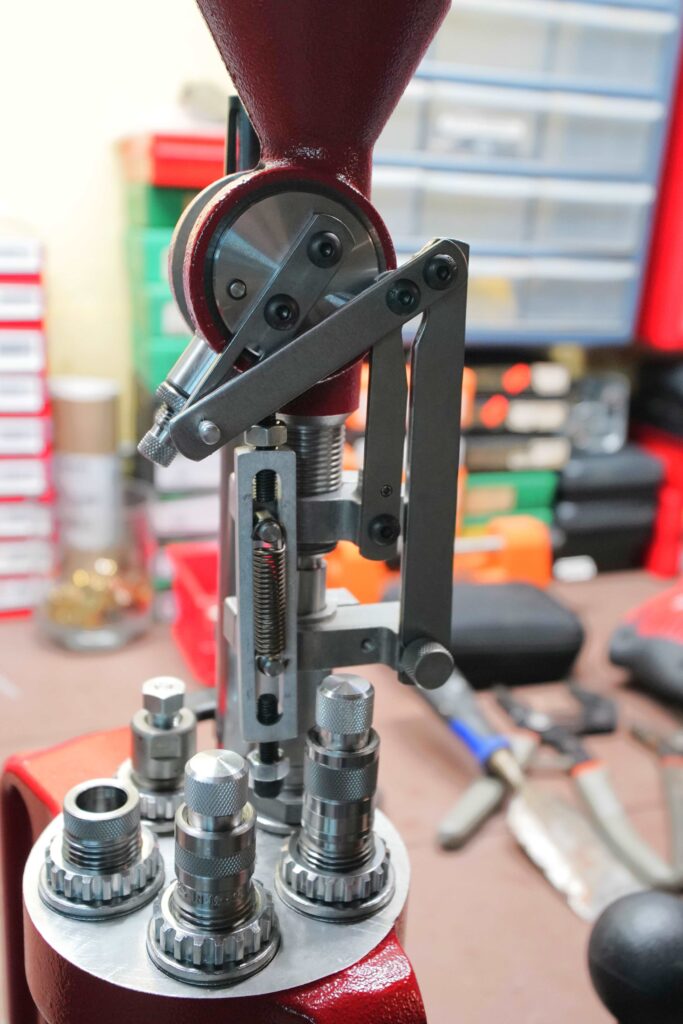Hornady has long been a household name in the firearms industry. While being known primarily for high-end ammunition, their role in the 2A community goes far beyond providing users with a variety of finished bullet products. Hornady produces some of the most acclaimed reloading equipment in the market supporting gun enthusiasts who want to be able to produce, control, and experiment with their own ammo. Since venturing into reloading equipment in 1971, Hornady has followed the footsteps of machine producing leaders with hundred-year-old names. Following RCBS and Lyman has improved Hornady’s manufacturing standards and innovative reloading technology. As a result, Hornady reloading equipment is famous for its well-roundedness in all categories of reloading tool market, beloved by hobby reloaders and industry professionals alike.
What Do They Make?
It is safe to say that Hornady have you covered for any piece of tooling required to reload a cartridge. Although Hornady does not make bullet casting equipment as Lyman, RCBS, and Lee Precision do, they make everything else necessary in house.
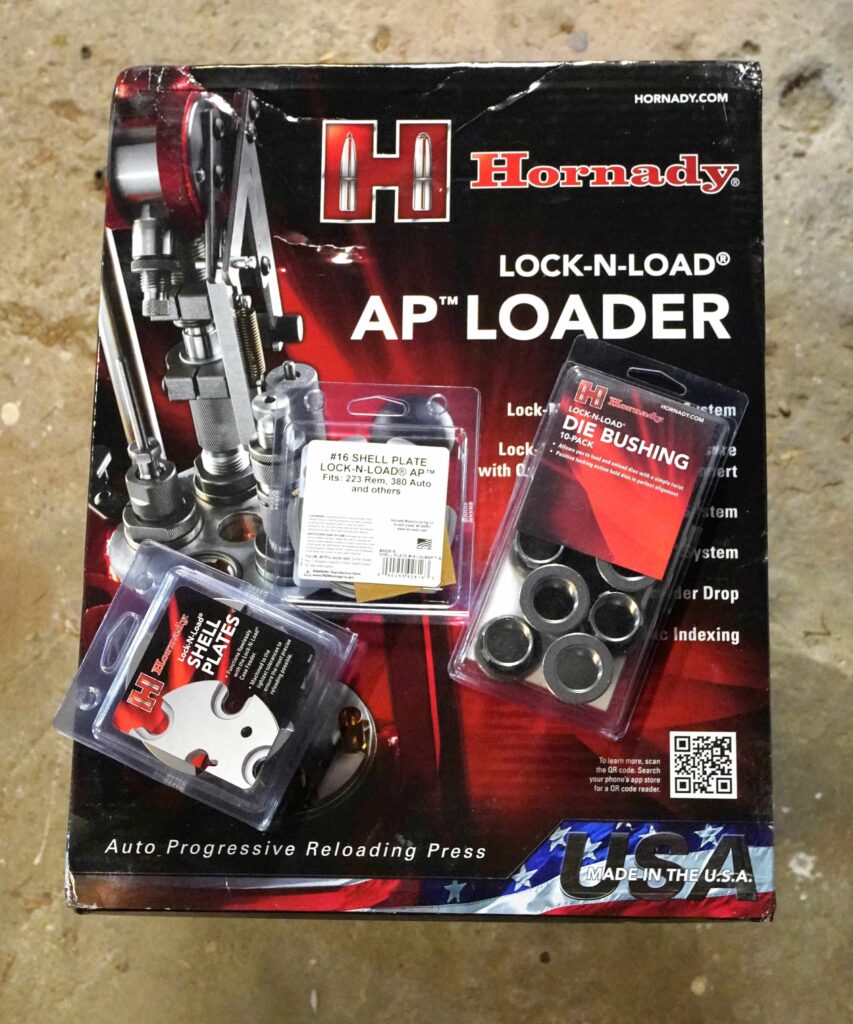
Hornady ships the Lock-N-Load AP Press kit in an obvious box, much like a statement piece.
What sets Hornady apart from other companies is the use of innovative tooling adjustments while retaining an incredibly strong standard. Hornady produces many reloading presses with the addition of a bushing. This allows a user to quickly change dies and reload multiple calibers without the time-consuming process of setting die spacing. Moreover, this bushing is far more affordable than an entire toolhead that houses and removes all the dies together. This means that a user can load multiple loads without changing every single die. By setting up several of the same caliber die sets to different specifications, everyone saves time and money.
Included within the kit is a wide range of tools and instruction guide for both the press and the
powder drop.
For example, if a user is loading a rifle cartridge in the same caliber – one for precision and one for general semi-automatic use – they can replace the crimp die and set a projectile only with neck tension. If they load two different projectile weights, then the user can change the bullet seat and/or crimp die to one preset for that specific bullet. In both instances, only one die needs to be changed instead of an entire toolhead.
Hornady’s Lock-n-Load AP Press is one of the newer reloading press models in the market and one of their bestselling presses. It is a 5-stage reloading press capable of handling all pistol cartridges and can handle most rifle cartridges except for a few excessively large calibers such as 50 BMG.
The two-hole mounting system makes it incredibly easy to attach to a bench without inconvenient bolt attachments
Hornady’s AP press appears to have been designed from the ground up for the multi-caliber reloader. It is equipped with quick-change bushings, modelled similarly after that of a rifle chamber with the ability to handle significant pressure. These bushings are so popular that adaptors are offered to be fitted to competitor presses. Baseplates can be changed seamlessly as well. Hornady’s various auto-indexing plates are sold separately for use with specific cartridges as there is no ‘one size fits all.’
Manufactured from a cast alloy, the construction of the press is durable and lighter weight than expected. An “O” shaped design offers rigidity and structure with strong resistance to pressures pushing upward. As opposed to a “C” or clamp design, which often suffers from lateral and horizontal movement when pressures are strong enough to bend the metal or alloy.
A reloader who reloads a wide range of pistol and rifle calibers will find the AP Press by Hornady incredibly useful.
With the five stages, the press accommodates various operations from reloading simple ammunition to advancing to more complex ones or those for competition shooting. While multi-step dies can be more convenient and faster to use, maintaining and operating it can be more challenging to some depending on their experience and knowledge. In this sense, Hornady’s Lock-N-Load AP Press offers a more ideal operative condition to those who want to take it step by step to achieve their best result.
Once mounted, the AP press sits comfortably at the end of a bench and doesn’t look much different than competitor’s presses, excluding the 5 stage attachments.
The Quick and Dirty About Progressive Presses
A progressive press allows a user to manufacture multiple pieces of ammunition at the same time. Presses are usually manufactured as single stage, turret, or progressive units. With a single stage or turret press, a user loads one single piece of ammunition from start to finish. Single stage presses also require the change of a die after every step of manufacturing or reloading. Therefore, after resizing all of the brass, the user needs to change the die for adding powder. However, progressive presses do multiple steps at the same time without the need for changing dies.
Mounting for the actuation handle is only available on the right-hand side of the press.
Each position or stage can perform a task, and all stages perform their tasks at the same time. When one case is being finished, another is being started, and this whole process happens with a singular handle pull. So, if you start reloading and pull the handle of the AP Press 10 times, you will get 5-10 pieces of complete ammunition whereas single stage or turret will produce roughly 3.
As another benefit to progressive presses, many can be outfitted with additional components that allow automation of bullet feeding, primer feeding, and powder dropping. With these accessories, a user only needs to refill hoppers and pull the handle.
Even Lee dies can be mounted without much work.
In The Shop
Upon arrival, our Lock-N-Load AP press came in a well-packaged, weighty Hornady box wrapped in Cellophane. Included were the press, a powder metering device to use on pistol and rifle cartridges, powder drop, cartridge catcher, primer tubes, and 5 bushings. Additionally, we received several caliber-specific shell plates that are typically not included in the press purchase.

Lee dies may fit, but there isn’t much room for adjustment left.
The setup was straightforward and laid out clearly in the instruction manual with photos of each step. Mounting it to a bench was also easy as there are several large holes in the base of the press to run bolts. With oversized holes, thicker bolts should be used providing a very strong mounting position. The length of the bolts is also important depending on the thickness of the user’s bench.
Overall, it is a great menacing addition to the reloading bench. The included power drop towers over many competitors, and its bright red finish makes a bold statement. While the press does not occupy a huge space, the towering height provides plenty of space for larger cases. With a full pull of the handle, any user can easily accommodate small to large cases.
Setup and First Use
The basic setup of the press is simple. Two holes drilled into the bench are all that hold it in place. When using smaller bolts, it’s important to use washers to protect both the finish and the bench top from additional stresses. Compared to competitors, this two-bolt mounting system is more effective and easier.
Once set on the bench, a shell plate is easily attached by only a single bolt in the center of the riser. No excessive torque is required as hand-tight appears sufficient. One major advantage of the Lock-N-Load AP Press is the use of a spring case retention system holding each case in place as opposed to individual retention pieces. The one disadvantage of this is that the last stage position allows the case to tilt slightly as we experienced later in the setup process. As a result, the case does not line up perfectly with the die and requires the user’s attention during operation. It should also be noted that the AP Press was preconfigured for large primer use and needed to be swapped for the small primer seat plug. The factory-installed components were tight, and the primer seat plug was placed in a way that was awkward to use an adjustable wrench for removal.
Hornady’s Lock-N-Load Powder Measure comes standard with the kit. Another big advantage compared to competitors.
For the first use, we chose Lee Precision Pacemaker to see how compatible Lock-N-Load AP Press would be with die sets from other companies. Hornady dies are well known as some of the very best, and most of the other big name die makers use similar length dies. However, Lee has shorter dies at an affordable price as well as incorporating an independent crimp die for use of all the stages. If the AP Press could easily accommodate Lee Precision dies, any other manufacturer would be compatible with the AP Press as well. With a quick installation of the bushing system, we screwed in the Lee dies, using every bit of threading real estate available. The fitting did not leave much wiggle room but still worked.
While setup is frustrating, the powder drop doesn’t require much adjustment when mounted.
The trickiest part of the installation was the powder drop. Coming in a few prices, the directions here were not as clear as they were in the other parts of assembly process. The three bushings included for the case actuation were not marked in any way although the photo in the manual was. It took a bit of internet searching and comparison to find the bushing suitable for 223 to find the right one and install it. Once complete, a few dry runs went well without any issues excluding the final stage requiring the adjustment of the case into the final die.
So, What’s the Gritty? Final Thoughts
The Lock-N-Load AP Press from Hornady is a well-constructed piece of reloading equipment worth the investment. The cast alloy is lighter weight than iron and appears capable of withstanding a degree of abuse. Their ‘O’ style design can resist deflection and fatigue with ease while making baseplate changes easy to reach and straightforward. Die bushings that can house various sizes of dies are an incredibly useful option that multi-caliber reloaders will be able to take full advantage of. As a right-handed user, the location of the handle is incredibly comfortable. It cannot be changed to the left size for southpaw, however.
As of writing this article, the Lock-N-Load AP Press by Hornady is available for $549.99. Bushings and baseplates are also available for $42-56 and $14-59 respectively. Users can also easily expand and add more options for case feeding or even bullet feeding found at Midsouth Shooters Supply.


